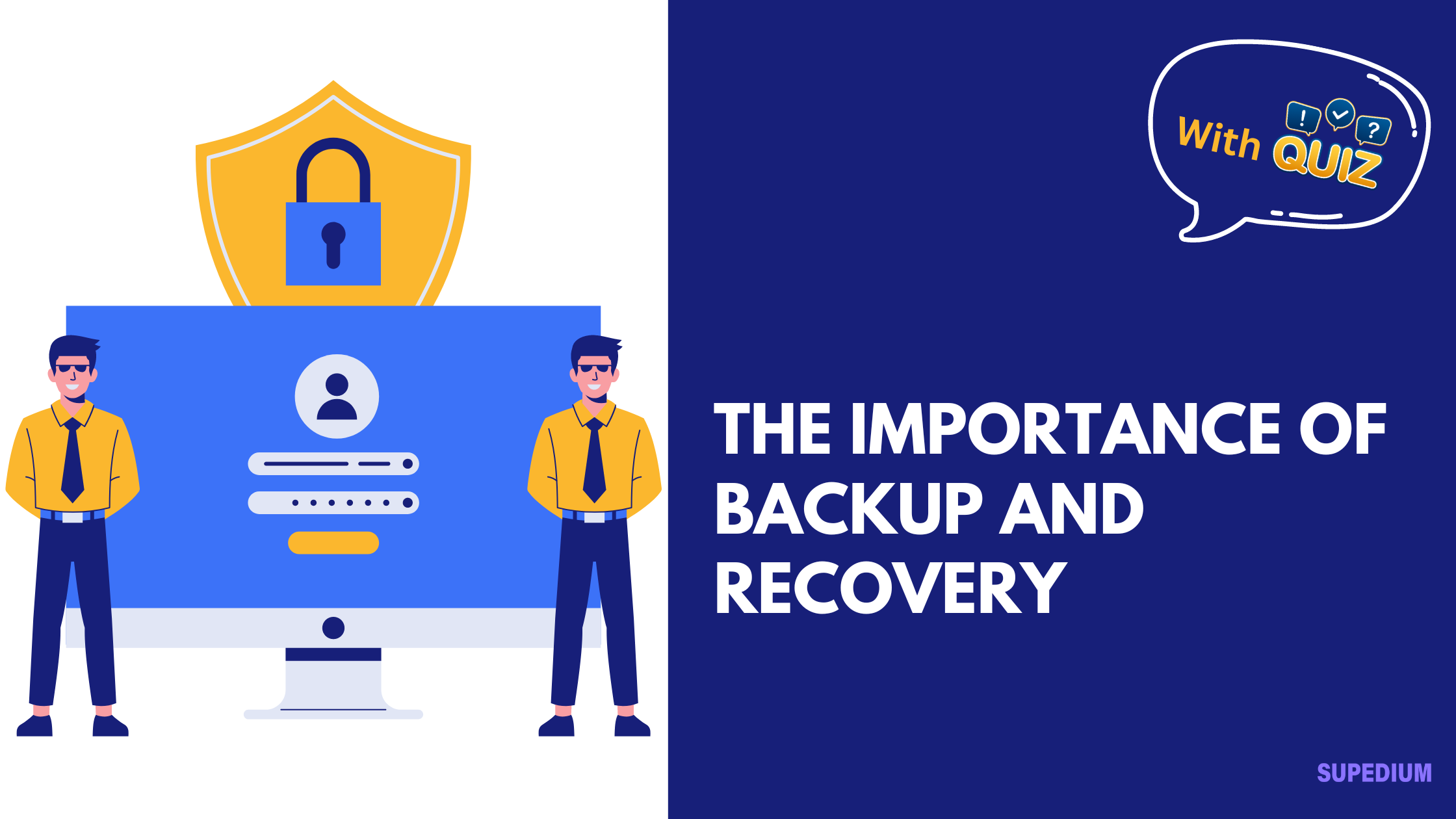Table of Contents
![]()
In an era where digital data is the lifeblood of organizations and individuals alike, the significance of backup and recovery cannot be overstated. Ensuring that data is protected and can be restored swiftly in the event of loss or corruption is crucial for maintaining operational continuity, safeguarding sensitive information, and complying with legal requirements. This article delves into the importance of backup and recovery, explores various strategies and methods, and outlines best practices for effective data management.
Understanding Backup and Recovery
Backup refers to the process of creating copies of data to protect it from loss or corruption. These copies are stored separately from the original data, ensuring that in case of data loss, the backup can be used to restore the original information. There are different types of backups, including full, incremental, and differential backups.
- Full Backup: A complete copy of all selected data. While it is straightforward and simplifies recovery, it requires significant storage space and time.
- Incremental Backup: Captures only the data that has changed since the last backup. This method is storage-efficient but requires a chain of backups for complete restoration.
- Differential Backup: Backs up data changed since the last full backup. It offers a balance between storage efficiency and simplicity of restoration.
Recovery is the process of restoring data from backups. It involves retrieving lost or corrupted data to return systems to their normal operation. Different recovery methods include complete, partial, and point-in-time recovery, each addressing various needs for data restoration.
The Importance of Backup and Recovery
1. Protection Against Data Loss
Data loss can result from various issues including hardware failures, software malfunctions, human errors, and cyberattacks:
- Hardware Failures: Hard drive crashes or server malfunctions can lead to complete data loss. Regular backups ensure that data is not permanently lost if hardware fails.
- Software Issues: Application crashes or operating system failures can corrupt data. Backups provide a safeguard against such failures.
- Human Errors: Accidental deletion or incorrect modifications can lead to data loss. Having recent backups allows for quick restoration to a previous state.
- Malware and Cyberattacks: Ransomware and viruses can encrypt or destroy data. Backups are crucial for recovery in such scenarios, preventing data loss and enabling quick recovery.
2. Business Continuity
Backup and recovery are essential for maintaining business operations:
- Minimizing Downtime: Quick restoration of data helps minimize downtime and keeps business processes running smoothly.
- Maintaining Customer Trust: Reliable backup and recovery systems ensure that services remain available, fostering customer confidence and loyalty.
- Financial Implications: Effective backup and recovery systems help avoid revenue loss and reduce operational costs by preventing prolonged outages and data loss.
3. Legal and Regulatory Compliance
Many industries have strict data protection regulations:
- Data Protection Regulations: Laws such as GDPR and HIPAA mandate strict data handling and protection measures. Regular backups help organizations meet these requirements and avoid legal penalties.
- Industry-Specific Requirements: Financial services and healthcare sectors have specific regulations for data retention and protection. Compliance with these regulations often necessitates robust backup and recovery solutions.
- Legal Obligations: Backups are essential for preserving evidence and complying with data retention policies, supporting legal investigations and audits.
Backup Strategies
1. Backup Types
Understanding the different types of backups helps in choosing the right strategy:
- Full Backup: Comprehensive but resource-intensive. Best used as a periodic backup complemented by incremental or differential backups.
- Incremental Backup: Efficient for daily backups, as it reduces the amount of data stored and backed up. Requires careful management of backup chains for recovery.
- Differential Backup: Provides a middle ground, balancing storage needs and recovery complexity.
2. Backup Methods
Selecting the appropriate backup method is crucial:
- On-Site Backup: Involves storing backups on physical devices at the same location as the primary data. It offers immediate access but is vulnerable to local disasters like fires or theft.
- Off-Site Backup: Backups are stored at a different physical location, protecting against local incidents. However, recovery may be slower due to distance.
- Cloud Backup: Uses cloud storage providers to store backups, offering scalability and remote access. Cloud backups can be cost-effective but depend on internet connectivity and third-party services.
3. Backup Frequency
Choosing the right backup frequency depends on data criticality and storage capabilities:
- Daily/Weekly/Monthly Backups: Establishing a regular schedule ensures data is up-to-date and manageable.
- Continuous Data Protection (CDP): Provides real-time backup, minimizing data loss. However, it requires significant storage and bandwidth.
Recovery Planning
1. Recovery Objectives
Setting clear recovery objectives helps in planning effective recovery strategies:
- Recovery Time Objective (RTO): Defines the target time for restoring data and systems. A shorter RTO minimizes downtime but may require more resources.
- Recovery Point Objective (RPO): Determines the maximum acceptable amount of data loss. A lower RPO means less data loss but may increase storage and backup frequency.
2. Recovery Processes
Developing and implementing recovery processes is vital:
- Disaster Recovery Plan: A comprehensive strategy detailing procedures for various disaster scenarios. It should be regularly tested and updated to ensure effectiveness.
- Data Restoration Procedures: Step-by-step methods for restoring data from backups. Regular verification of data integrity is crucial to ensure successful recovery.
3. Testing and Maintenance
Regular testing and updating of backup and recovery plans are essential:
- Regular Testing: Conduct restore drills and verification tests to ensure backups are functional and recovery processes work as expected.
- Plan Updates: Continuously review and update backup and recovery plans to reflect changes in technology, data, and business processes.
Challenges and Solutions
1. Data Volume and Growth
Managing large volumes of data requires efficient backup and storage solutions:
- Strategies for Efficient Backup: Utilize compression, deduplication, and tiered storage to manage data growth and reduce costs.
2. Security Concerns
Protecting backup data from unauthorized access and breaches:
- Encryption and Access Controls: Ensure that backup data is encrypted and access is restricted to authorized personnel only.
- Secure Backup Storage: Implement physical and digital security measures to safeguard backup storage.
3. Cost Considerations
Balancing cost with backup and recovery needs:
- Cost-Effective Solutions: Evaluate different backup solutions to find a balance between cost and coverage, considering factors like storage needs and recovery speed.
Best Practices
1. Regular Backups
Establish a consistent backup schedule and monitor processes to ensure reliability and completeness.
2. Data Integrity Checks
Regularly verify the accuracy and completeness of backups using checksums and validation procedures.
3. Documentation and Training
Document backup and recovery procedures clearly and train staff to ensure they can effectively execute recovery plans during emergencies.
Conclusion
In a digital age where data is invaluable, maintaining effective backup and recovery systems is essential. These systems protect against data loss, ensure business continuity, and help meet legal and regulatory requirements. By understanding backup strategies, implementing robust recovery plans, and adhering to best practices, organizations can safeguard their data and ensure operational resilience in the face of unforeseen events. Regular reviews and updates to backup and recovery plans will help adapt to evolving needs and technologies, securing data against potential threats and ensuring continued success.






Be the first to comment